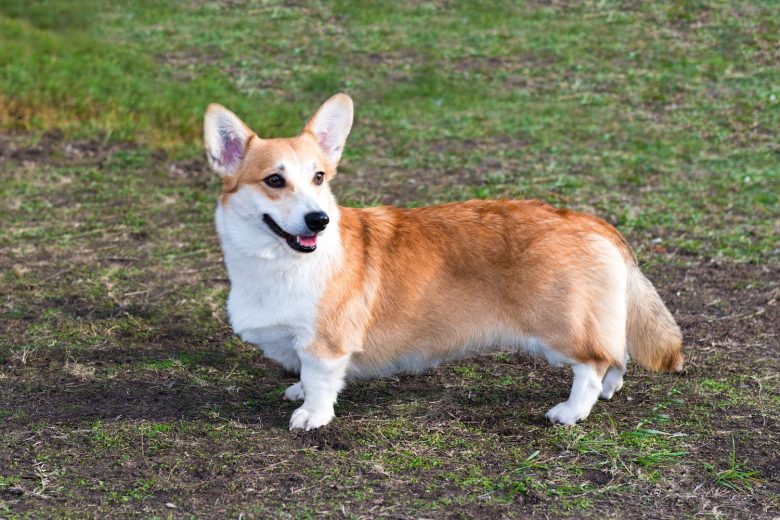The working history of the Cardigan Welsh Corgi is pretty impressive. Over the centuries, they have worked as cattle, pig, and goose drivers and herders; livestock guardian dogs; gundogs for furred and feathered animals; ratters; and family guard dogs.
Table of Contents
Cardigan Welsh Corgis as Watch Dogs?
Guard dogs: Like many protective and loyal pups, the Cardigan Welsh Corgi has proven to be a reliable guard dog. This breed can be loyal to fault, ready to turn on any intruder or threat on the property. Corgi’s large ears are able to detect minute sounds across great distances, and determine whether or not there is cause to be concerned. They have acute hearing abilities and do not shrink from sounding the alarm when there is any unusual noise or scent. Though they need to be trained not to nip at the feet of the young people in their home, their herding instincts are beneficial to have in a guard dog.
Are Cardigan Welsh Corgis Aggressive?
The Cardigan Welsh Corgi is highly intelligent and obedient, able and willing to please its owner. Reliable, dedicated and loving, but can be wary of strangers. Socialize well, preferably when young. Corgis are extremely active and devoted little dogs, and are good with considerate children so long as the dog sees himself below humans in the pack order. Protective and sturdy, they make fine guards, and excellent show and obedience dogs. Good with other non-canine animals, but can be combative with other dogs if the owners do not properly communicate to the dog that aggressiveness is an unwanted behavior. They sometimes attempt to herd people by nipping at their heels, and should be taught not to do this. The Pembroke tends to bark a lot and makes a good watchdog. If you find your dog is barking at you in order to communicate, you need to hush the dog and look into your leadership skills. A dog that is barking at you in that manner is showing signs of dominancy issues. If you can treat your Corgi in such a way that he is mentally sound, he makes a wonderful companion. Issues will arise if the dog is above the humans in the pack order and if he does not receive enough daily exercise. Do not allow the Corgi to developed Small Dog Syndrome.
Cardigan Welsh Corgis Background
The Cardigan Welsh corgi is the older of the two corgi breeds, which came to Wales with the Celts around 1200 BC. Some feel that the Swedish valhund (of similar build) may be in the background, since they were brought to the British Isles by the Vikings. The word corgi has multiple possible origins. Some think that it is Celtic for dog, while others think that the name comes from “cor” for dwarf or “to gather”and “gi” for dog. Certainly both derivations fit.
Family and Bonding
Before you start grooming your Cardigan Welsh Corgi, make sure he feels safe and relaxed. Be patient and gentle. In time, your Corgi will grow to love and enjoy the grooming sessions.
Friendly
Cardigan Welsh Corgi puppies are little fluff balls of absolute cuteness! And they’re not just good looks. Corgis are also known to be extremely affectionate, easygoing, and friendly to both people and other pets.
Cardigan Welsh Corgi Nature
Welsh farmers used Cardigan Welsh corgis' herding skills as natural boundary protectors to keep neighboring cattle off their lands. Often referred to as drovers, Cardigans were also essential for animal relocation and as pasture guardians. Short stature and stamina helped them avoid being kicked by fast-moving hooved cattle and sheep, and their watchful nature and swift footing enabled them to respond to trouble at a moment's notice.
Intelligence
Easy Training: Cardigan Welsh Corgis are eager learners and quickly understand what is expected of them. The Cardigan Welsh Corgi excels at dog sports such as sheepdog and agility trials.
Love
Cardigan Welsh Corgis as a Pack Animal
Super smart, the Cardigan Welsh Corgi needs proper socialization and training from the get-go, or else he’ll become quite bossy.
Physical Traits
The Cardigan Welsh Corgi is a long, low to the ground dog. Their backs are actually not longer than most dogs’, their legs are just very short in comparison. The topline is level. The head is in good proportion to the rest of the dog. The broad, flat skull is rounded and tapered. The muzzle is parallel with the skull and has a moderate stop. The nose is black in all colors but may be butterfly in merle-colored dogs. The teeth meet in a scissors bite. The wide-set eyes are medium to large in size with dark rims. The oval eyes are shades of brown depending on the dog’s coat color. Dogs with a blue merle coat may have blue eyes, either both eyes, or one of each. The eye rims are black. The erect ears are large in proportion with the rest of the dog, moderately large at the base and slightly rounded at the tips. The chest is deep with a prominent breastbone. The legs are very short. The tail is low-set and long. Dewclaws are usually removed. The round paws are relatively large and the front feet turn out slightly. The double coat has a short, thick, weather resistant undercoat with a longer, coarser outer coat. The coat is longer at the ruff, back of the legs and on the underside of the tail. Some Corgis are born with longer coats called the "fluffy Corgi" or "long-haired Corgi. " These dogs do not make the written standard and cannot be shown. Coat colors include red, sable, fawn, brindle, black and brindle, blue merle (black and gray; marbled), black and tan with white markings. There are often white markings on the legs, chest, neck and parts of the muzzle.

